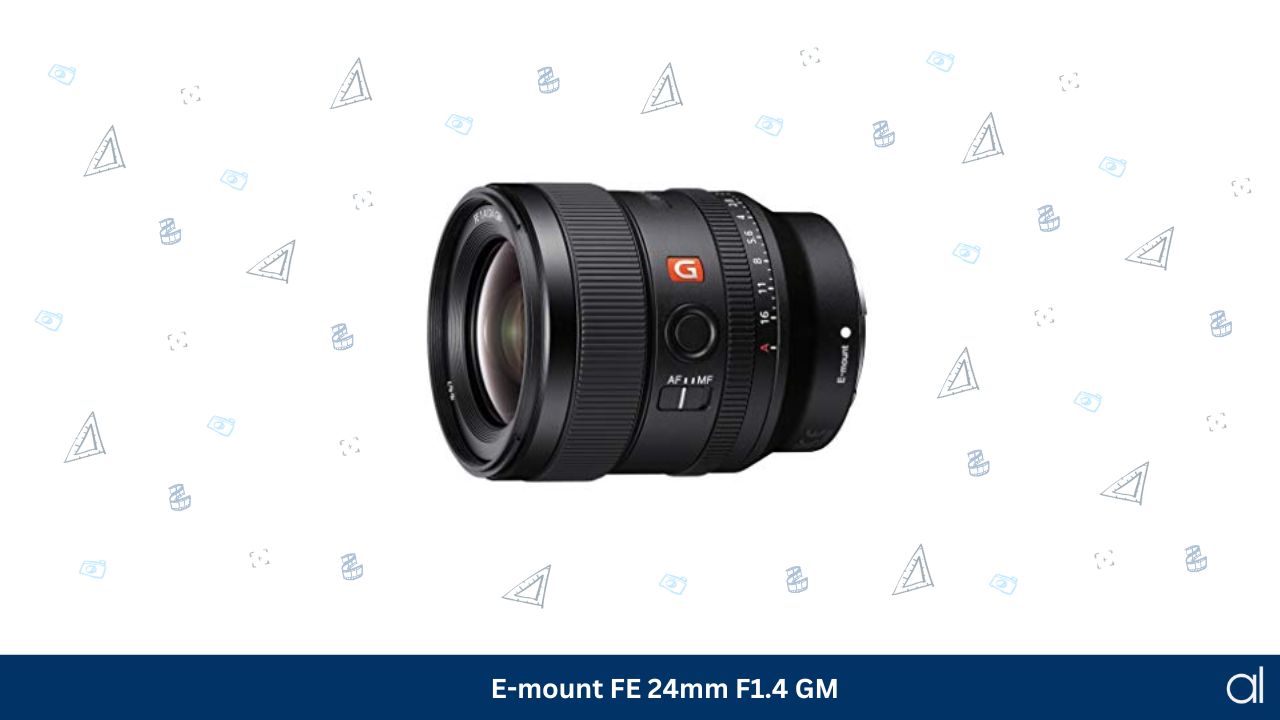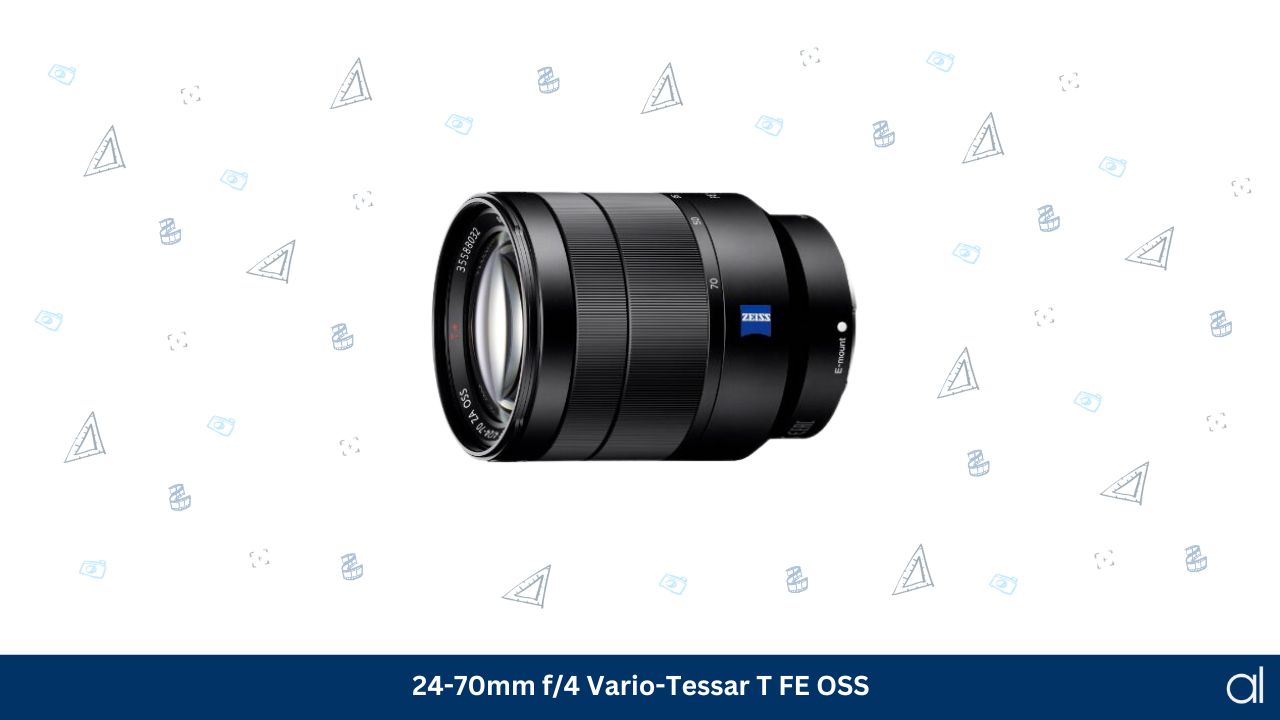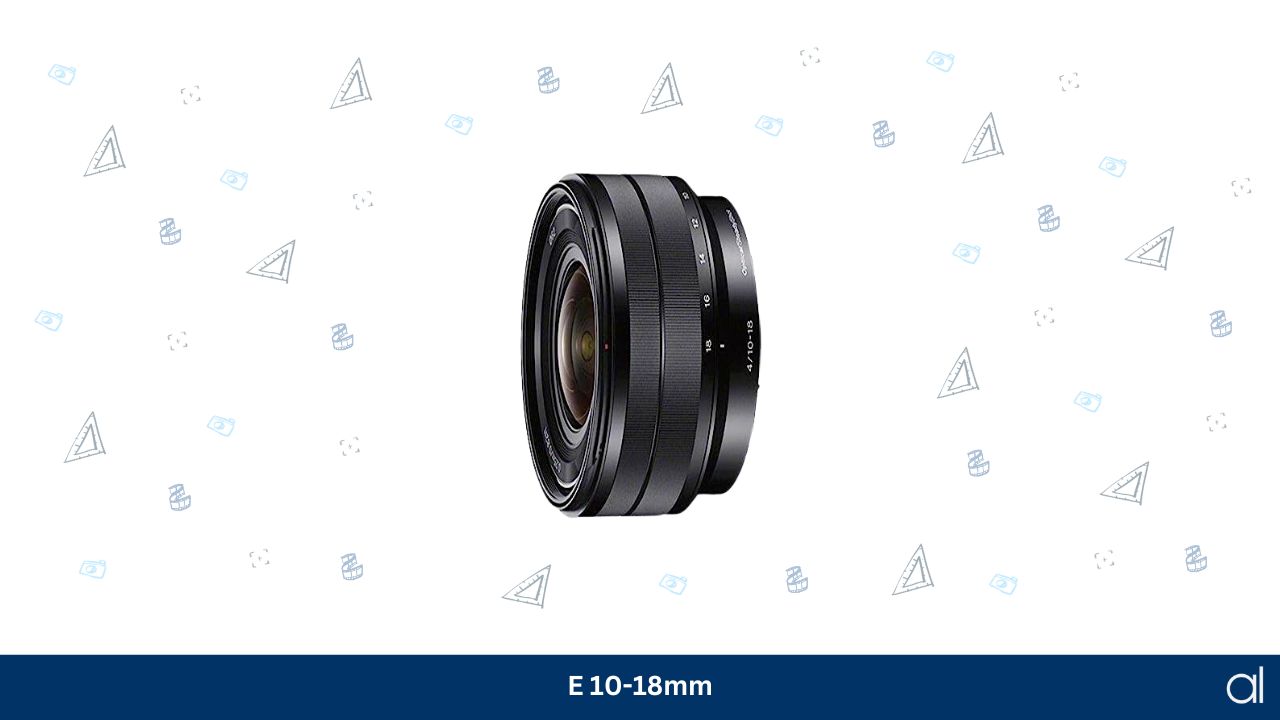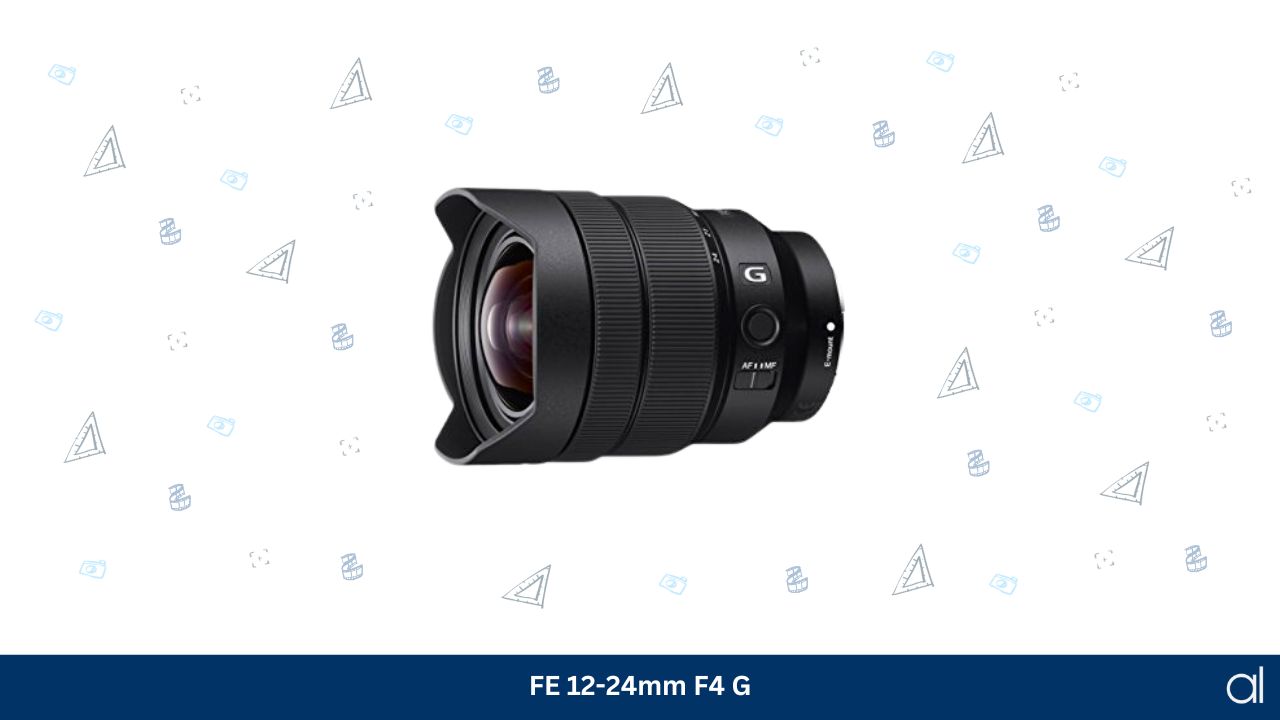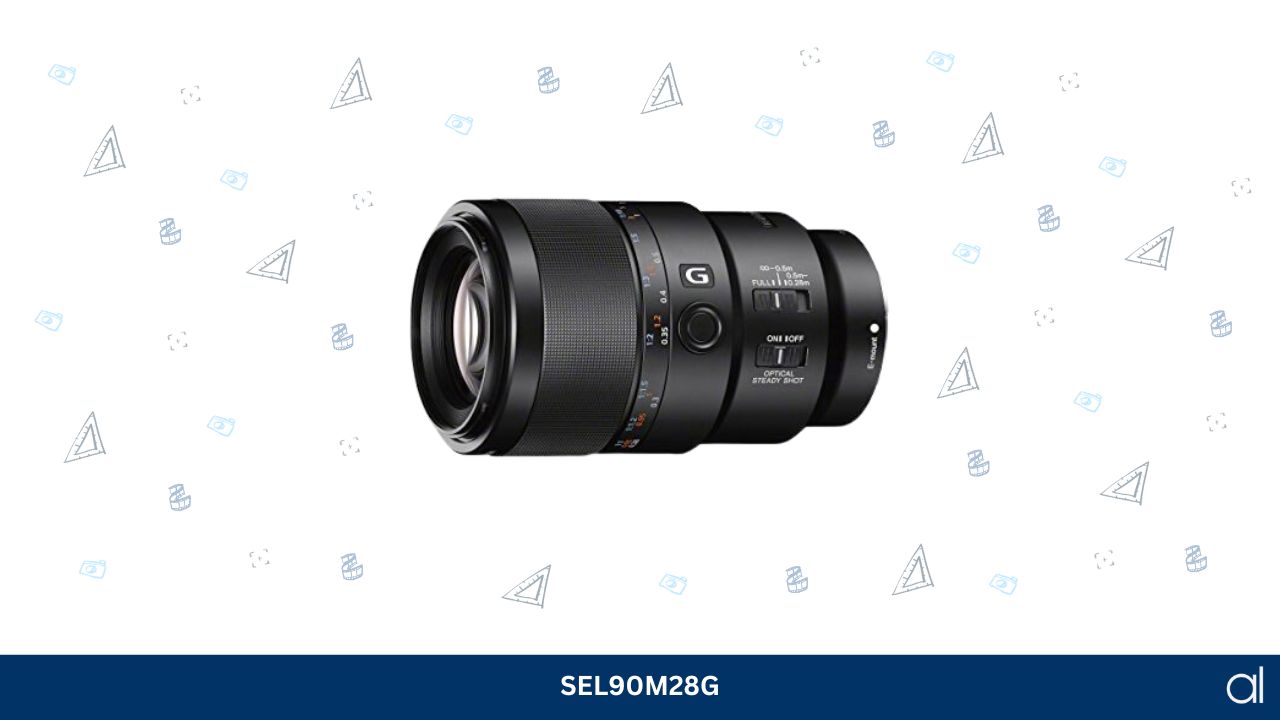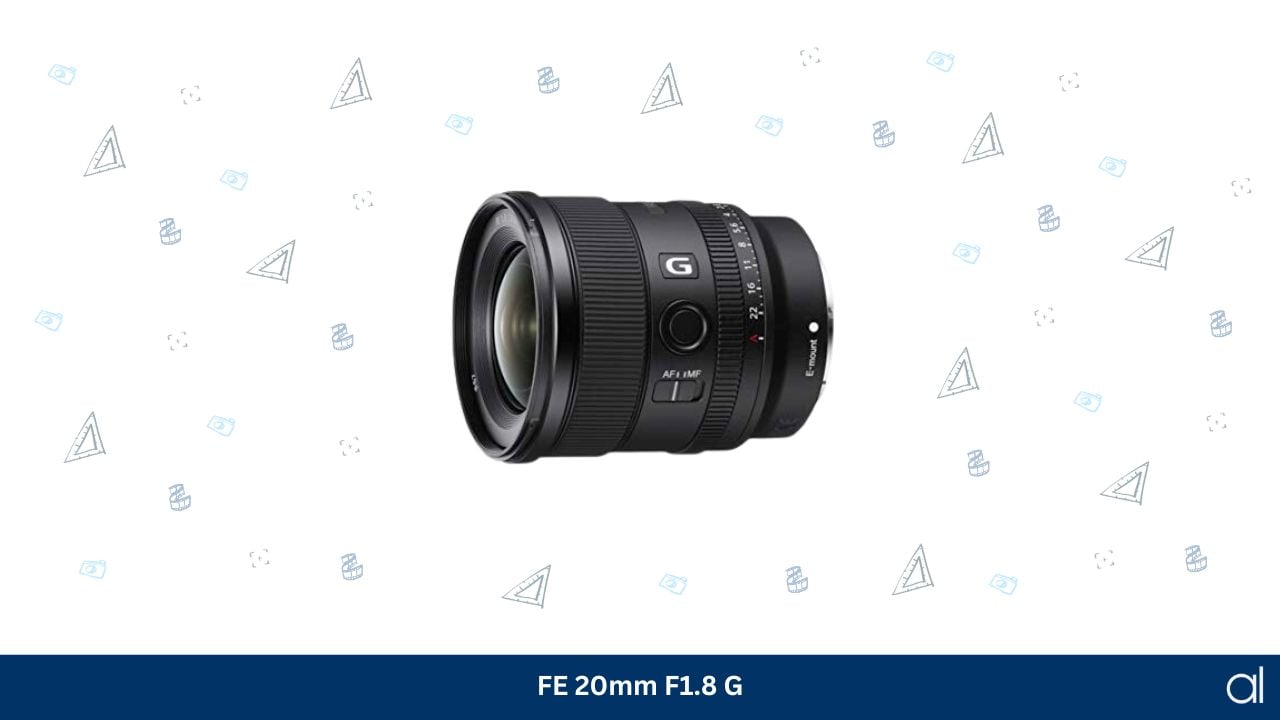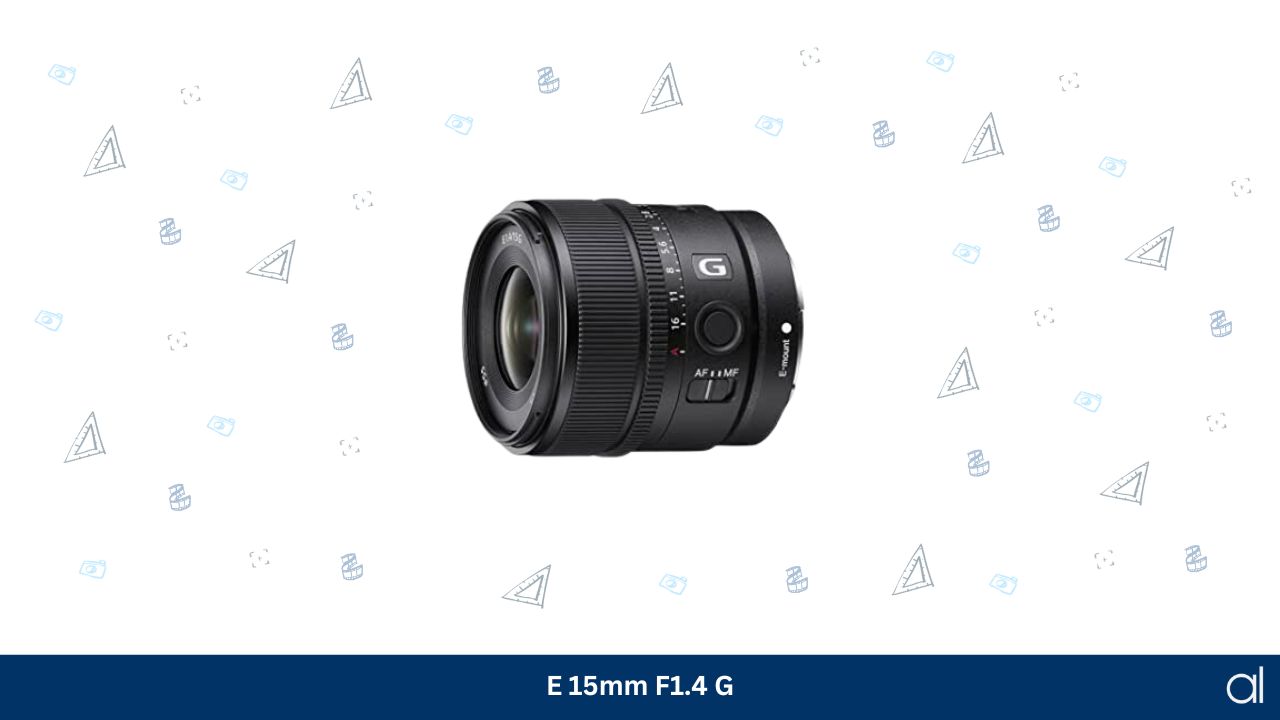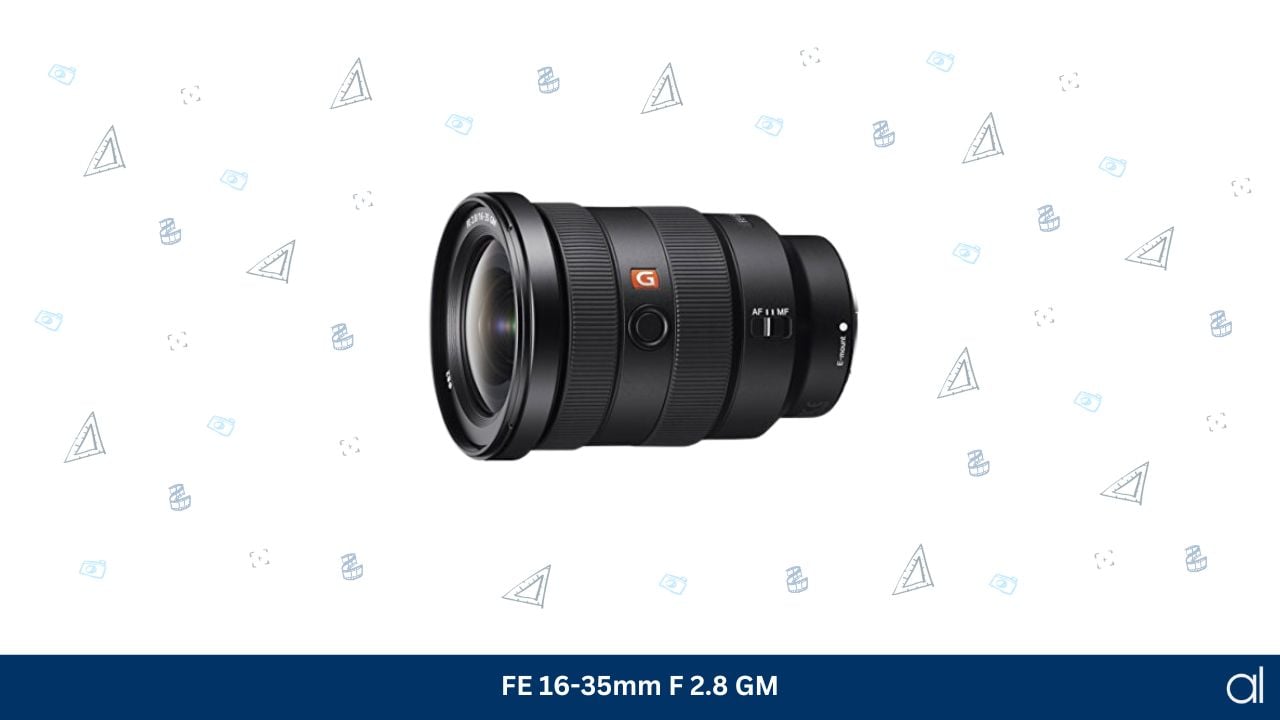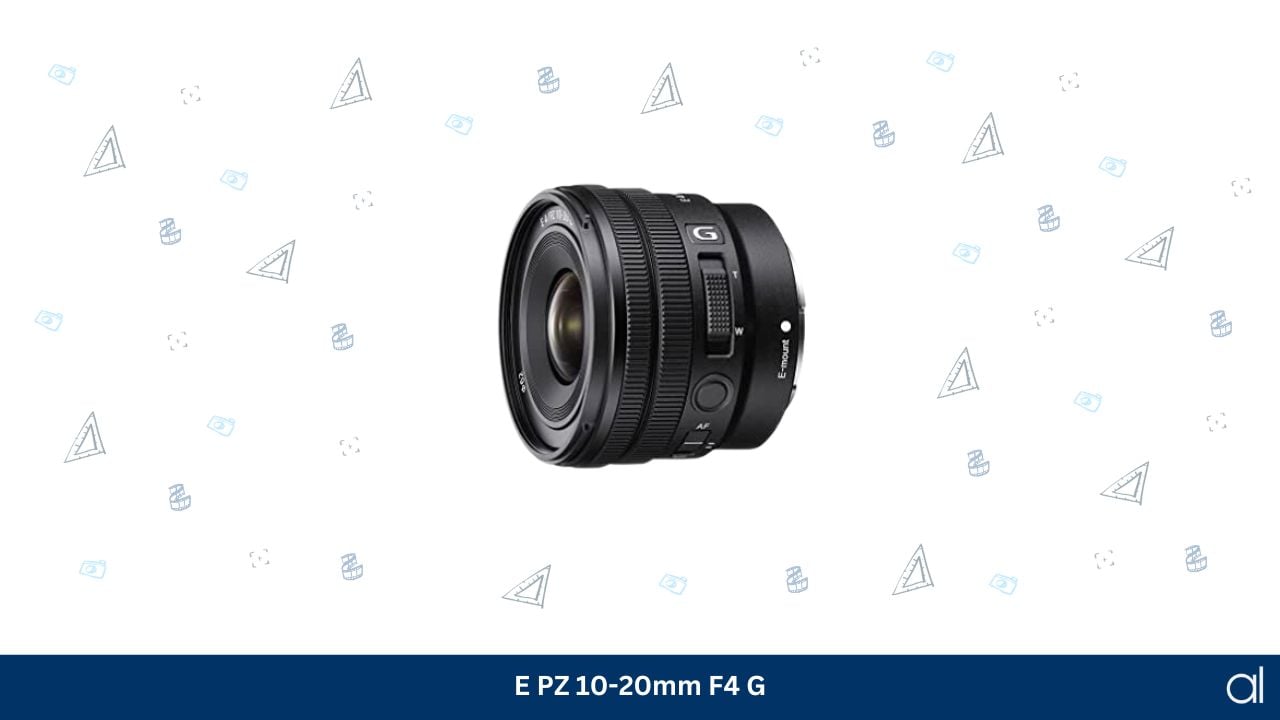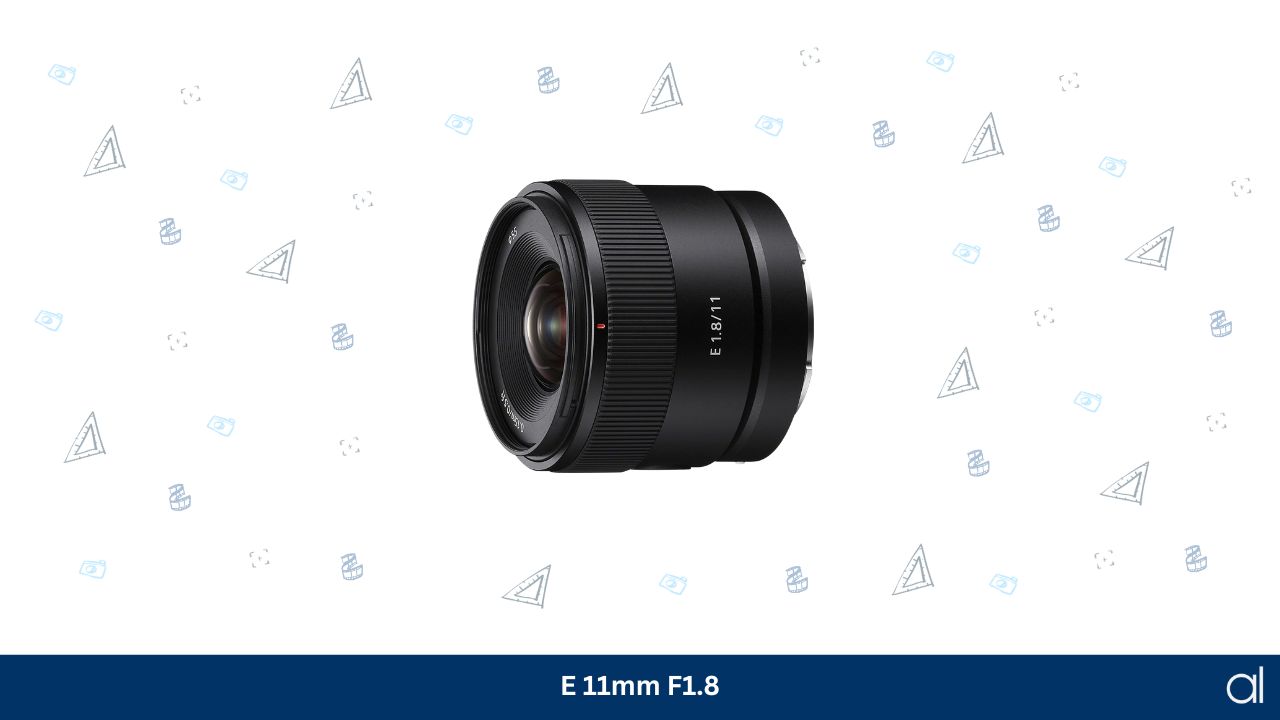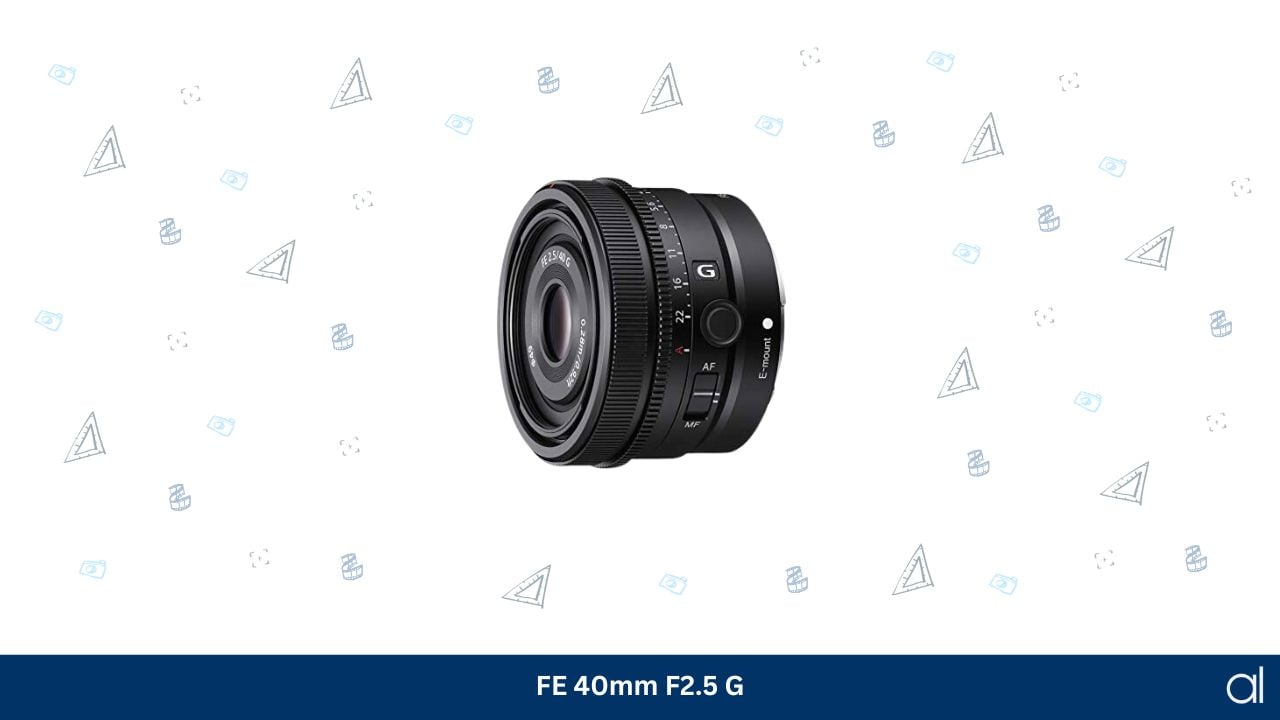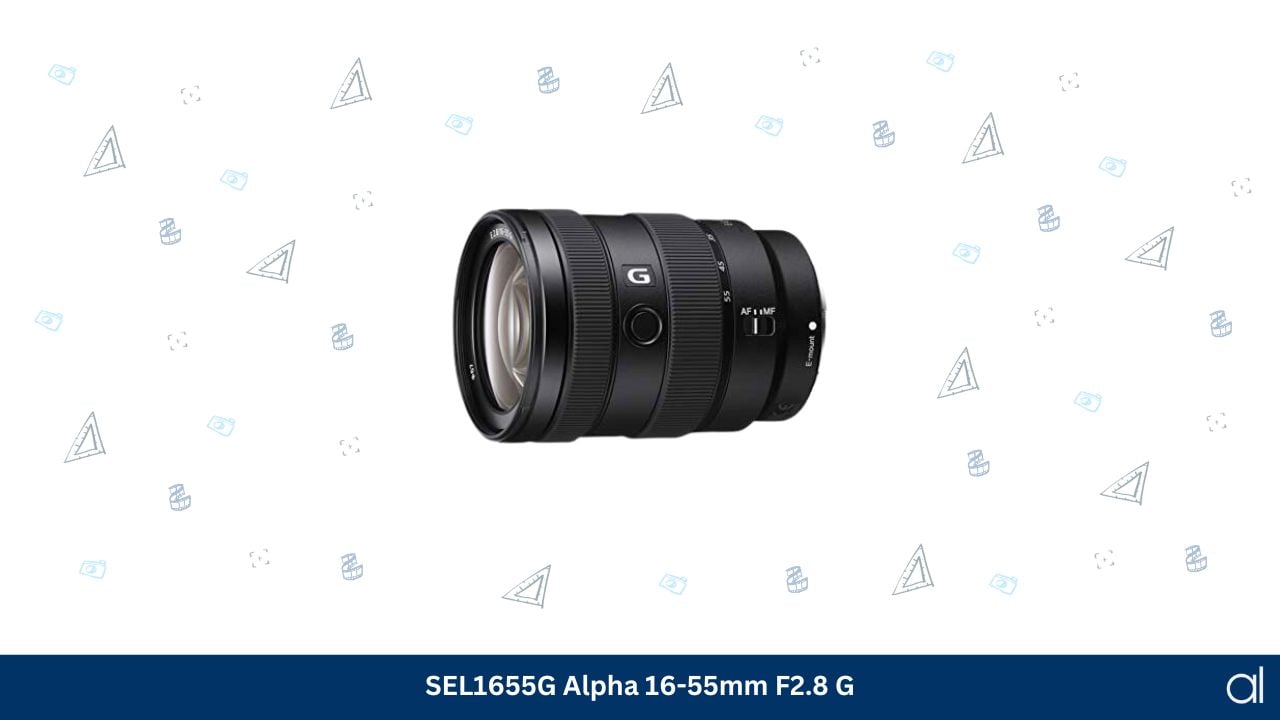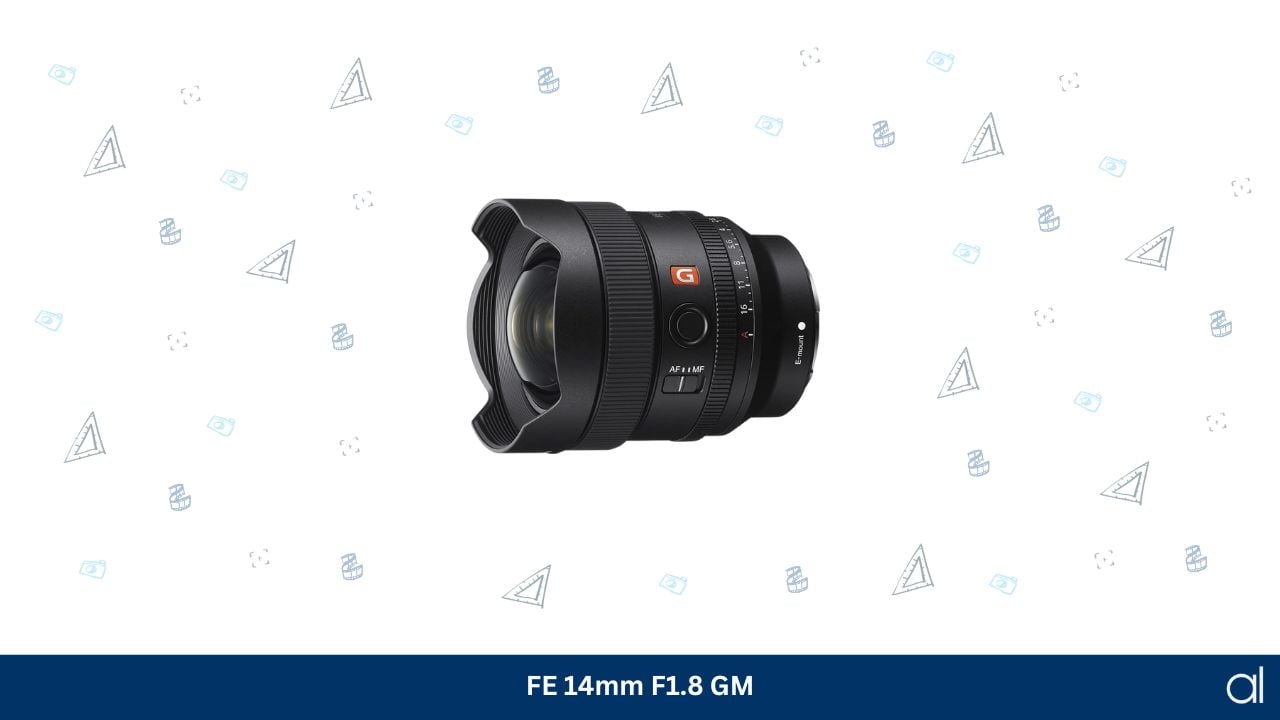Sony lenses for architectural photography are key to capturing the intricate details and stunning perspectives of buildings. The right lens can make or break your photography experience, enabling you to bring light to a fixed point of focus and produce sharp, detailed images that highlight every architectural element. With Sony’s reputation for quality optics, their range of lenses offers excellent options for both professionals and enthusiasts.
However, with so many options, how do you choose the perfect lens for your needs? In this guide, we’ll take you through the 13 best Sony lenses for architecture photography. From the FE 24 mm F/1.4 GM Prime Lens with its superb optical design to the durable FE 24-70 mm F/4 Lens and the compact E 10-18mm F4 Zoom Lens, we’ll help you navigate the best choices available.
Let’s explore the top Sony lenses that will elevate your architectural photography to the next level.
1. E-mount FE 24mm F1.4 GM Full Frame Wide-Angle Prime Lens – Best Sony Lens for 11-Blade Circular Aperture Mechanism
If you are browsing for the best Sony lenses for architecture photography, my first recommendation would be the E-Mount FE 24 mm. This full-frame camera lens is a great addition to the G Mark Series of Sony, and needless to say – it helped me achieve excellent architectural shots easily.
One of the best aspects of this Sony Full Frame Cameras Len is its optical design. After putting it to the test, I discovered that this arrangement helped me upgrade the image quality of my photographs. The product comes with two Extreme Aspherical and three Extra-Low Dispersion Elements, and as I shot at the F/1.4 in aperture – the corner-to-corner resolution impressed me.
As an architectural enthusiast, I needed the point light sources to be accurately produced by my Sony Lenses. Based on my observations, this lens excels in this aspect. Further, the Nano AR coating of this lens for Sony cameras reduces the ghosting and lens flare issues, which helped me maintain excellent image clarity and contrast.
I could easily isolate my subjects from the foreground and the background to capture their essence. This E-mount lens has an 11-blade circular aperture mechanism too, which creates a stunning bokeh.
The full-frame camera lens is equipped with a Direct Drive Super Sonic (DDSS) system which upgrades its autofocus performance. Further, I found it lightweight and compact compared to all the features that it comes with. Since architectural photography requires one to capture the different sides of the subject, the relatively improved mobility with this wide-angle lens was definitely a plus point for me.
I also liked the fact that this Sony lens is weather-resistant, proving durable and does not degrade due to the presence of dust or moisture in the surroundings. Based on my personal trials, the focal length range and ability to perform in challenging shooting environments make this lens an excellent option for outdoor photography. However, I felt that the focus speed degrades slightly in low lighting.
What We Like
- Great optical design
- Accurate point light source production
- Direct Drive Super Sonic System
- Weather-resistant
What We Don’t Like
2. 24-70mm f/4 Vario-Tessar T FE OSS Interchangeable Full Frame Zoom Lens – Best Sony Lens With Extra-Low Dispersion Glass
If you are looking for features like a strong build and versatility in your lens, I recommend the Sony Vario-Tessar T FE OSS Interchangeable Lens. You can maintain consistent exposure settings throughout the focal length range, making it one of the best zoom lenses for architecture photography on the market today.
I have always disliked the conventional aperture blades of lenses that create polygonal-shaped points of light. They are defocused and degrade the quality of my architectural photography, which is why I prefer the circular aperture of only the best Sony lenses – such as this one. This Vario-Tessar lens helps me defocus naturally and smoothly.
Thanks to the Extra-Low Dispersion Glass, I never had to deal with increased chromatic aberration while photographing at telephoto ranges. This lens also features Super ED Glass, which effectively compensates for the aberration, thus helping me achieve excellent image quality while shooting architectural subjects.
It also boasts aspherical elements near the diaphragm of the lens, which helps it restore the ray alignment and reduce image distortion. Further, I liked that the lens comes with Carl Zeiss T-coating, making it one of the best Sony lenses with optical excellence.
This coating helps prevent lens flare, light scattering, and internal reflection, which in turn helped me achieve a decent image quality as I photographed different architectures. The interchangeable full-frame camera lens also comes with a T* symbol, which tells me that it meets the highest quality standards Carl Zeiss set.
Drawing from experience, the image stabilization feature of this Sony lens is quite impressive. It has built-in gyro sensors that detect the smallest movements and counteract any possible image blurs. Hence, I could achieve exceptional image stabilization in both still architectural photography and videography.
After putting it to the test, I found the build of this lens to be quite solid. The zoom ring seems to be tight enough for convenient use and is responsive. It feels premium as I use it for my architectural photography, yet it is not so heavy that it becomes impossible to travel with. However, I wasn’t a fan of the soft edges that showed up at F/4.
What We Like
- Strong build
- Comes with Extra-Low Dispersion Glass
- Carl Zeiss T-Coating
- Great image stabilization
What We Don’t Like
3. E 10-18mm F4 OSS Wide-Angle Zoom Lens – Best With APS-C Mirrorless System
If you like working with ultra-wide zoom lenses while clicking pictures of alluring architectures, I recommend trying out the Sony E 10-18 mm F4 OSS. It pairs decently well with my mirrorless cameras and is the only ultra-wide lens for an APS-C mirrorless system on this list.
Since I wanted ideal zoom lenses for landscape and architectural photography, I found the zoom range of 15 to 27 mm impressive on my full-frame camera. It accommodates the factor of 1.5 crop well, and the f/4 worked well with my camera.
Although zoom lenses capable of working with such wide angles are usually bulky, I found this one to be surprisingly compact and lightweight. I also liked the metal mounting plate on this lens as it was sturdy and came with a petal-shaped hood.
Based on my observations, the feature of the Optical SteadyShots (OSS) stabilizer boasts a three-stop performance that ensures sharp images, irrespective of what kind of environment you shoot in. This is one of the best Sony lenses in terms of optical performance and comes with a total of 18 elements distributed in 8 groups. Due to their presence, I could do architectural photography without worrying about issues like reduced sharpness or increased color fringing.
I found this product to excel in center sharpness across the entire zoom range of the lens. Based on my first-hand experience, the absence of weather-resistant features levels up its maintenance, so you should ensure that you keep the lens away from dust and moisture.
What We Like
- Ultra-wide lens
- Great zoom and focal length range
- Compact
- Comes with OSS
What We Don’t Like
4. FE 12-24mm F4 G Wide-Angle Zoom Lens – Best Sony Lens for Ultra-Wide Photography
Are you looking for the best Sony lenses for architecture photography that are both lightweight and deliver excellent performance? You should check out the FE 12-24 mm F4 G Wide-Angle Zoom lens by Sony. Many people consider it to be one of the best wide-angle lenses manufactured by the company, as the four aspherical elements effectively suppress the aberrations.
As a result, whenever I used this particular lens for architectural photography, the results were always sharp and high-resolution images that kept the value of the G Lens Brand intact.
The circular aperture blades create a beautiful bokeh, which allows me to defocus the background of my architectural subjects smoothly. Moreover, features like the Direct Drive Supersonic Wave Motor (DDSSM), Nano AR Coating, and weather resistance make this product shine out among its competitors.
I was also impressed with the convenient design of this Sony Lens. For instance, it comes with an instant manual focus selection and a focus hold button. Additionally, its front lens element has a fluorine coating, which helps prevent issues like fingerprints and dust accumulation on the surface of the lens.
However, it is slightly expensive, which can be an issue for photographers on a tight budget.
What We Like
- Ultra-wide
- Lightweight
- Durable design
- Fluorine coating
What We Don’t Like
5. SEL90M28G FE 90mm f 2.8 – 22 Macro G OSS Standard-Prime Lens – Best Sony Lens With 1:1 Magnification
Macro-photography enthusiasts who have a mirrorless camera should consider checking out the Sony FE 90 mm F/2.8 Macro G OSS Lens. Giving it a try showed me that the lens is capable of delivering exceptional sharpness, minimal distortion, and great stabilization.
For me, one of the best standout features of this F 2.8 lens is its 1:1 magnification. Since I love capturing the intricate details that are engraved on my architecture subjects, this feature helped me photograph even the smallest details with stunning clarity. The lens also comes with built-in optical stabilization, which will help you click sharp images whether you prefer handheld photography or use a tripod.
G Lenses series of Sony are known for its bokeh quality, and the 90 mm F 2.8 variant does not disappoint. The combination of advanced optics, Nano AR coating, and a nine-blade circular aperture come together to help render sharp in-focus with reduced aberrations.
While the focus hold button will allow you to lock your desired focusing distance effectively, the focus range limiter helps prevent the tiresome hunting process. This lens by Sony also comes with a Direct Drive SSM, which delivers a quiet yet impressive performance. However, it is very bulky, which makes it difficult to travel with this lens.
What We Like
- Macro lens
- Minimal distortion
- 1:1 magnification
- Focus range limiter
What We Don’t Like
6. FE 20mm F1.8 G Full-Frame Large-Aperture Ultra-Wide Prime Angle G Lens – Best Sony Lens for Night Photography
If you have ever tried architectural photography at night, you must have faced some common issues, such as being unable to capture the details of the subject. In such cases, I suggest that you try out Sony FE 20mm F 1.8 G Lens. The large aperture and ultra-wide angle G lens together deliver decent performance, even as you capture your subjects under the starry skies.
After spending time with this lens, I can say that its optical performance is quite impressive. With two AA and three ED Glass elements, I had to deal with little sagittal flare. These elements also produce point light sources and high contrast, thus enhancing the final results significantly.
The Nano AR and fluorine coating on the lens elements ensure that the user does not face any issues with dust and debris accumulation. Further, the F.18 and the nine-blade circular aperture helped me create an aesthetically-pleasing background blur.
This lens further features Extreme Dynamic Linear Motors, which helped me lock focus precisely and quietly. It even has an internal focus mechanism, ensuring responsive and continuous autofocus. After closely examining the product, I feel that along with architectural photography, it is suitable for videography purposes.
Whether you possess full-frame Sony cameras or APS-C bodies, you can use this versatile lens with them all. Although I wasn’t a fan of the occasional focus breathing, this product is overall worth its price.
What We Like
- Good low-light performance
- No sagittal flare
- Nine-blade circular aperture
- Comes with Extreme Dynamic Linear Motors
What We Don’t Like
7. E 15mm F1.4 G APS-C Large-Aperture Wide-Angle G Lens – Best Sony Lens With a Large Aperture
I recommend the Sony E-Mount 15 mm F 1.4 G Lens to anyone who wishes to invest in the best Sony lenses for architecture photography, irrespective of their price. The large aperture of this wide-angle lens and dynamic perspectives can help you achieve stunning results with no hassle.
If you have compact APS-C or Super35 E-Mount cameras, features like the compact size and low weight will make this lens a good addition to your photography kit. The length of this lens remains unchanged as you try to focus on your subject, thanks to its refined internal focus mechanism.
This 15 mm F 1.4 G lens consists of two linear motors, which provide fast and precise autofocus. Both beginner and professional photographers can use this lens for their Sony cameras (or any compatible camera).
Photographers who despise the unnecessary focus breathing will like this lens because they do not have to deal with it at all. The lens also comes with weather protection features, allowing you to attain excellent image quality and an uncompromised focal length range. However, I was a bit disappointed that this lens did not have any anti-smudge coating of fluorine on it.
What We Like
- Value for money
- Dynamic perspectives
- Refined internal focus
- Weather sealing feature
What We Don’t Like
8. FE 16-35mm F 2.8 GM Wide-Angle Zoom Lens – Best Sony Lens With an Edge-To-Edge Performance
If you prioritize crisp images over anything else, I would recommend you go for the Sony FE 16 – 35 mm F.28 GM Lens. This wide-angle zoom lens offers users a variety of features like a good build, impressive optics, and excellent image quality. After trying out this product, I have to say that I agree with most of the claims made by the company about its functionality.
First things first, this lens delivers a very decent image quality with every click. As I installed this lens on my camera, I found the photographs to be very sharp and detailed. It would not be an exaggeration that it is at par with the best Sony lenses! At the setting of 16 mm and f 2.8, I was impressed by the edge-to-edge performance of this product.
This lens also boasts a black polycarbonate barrel finish, which gives the product a sleek appearance – perfect for professional photography. Components like the focus and zoom rings of the lens are knurled, which is why it is very easy to grip them and make the necessary adjustments. As per my opinion, you can use this lens for street photography as well.
However, the only thing that disappointed me in this lens is the issue of distortion. While at 35 mm, it is a slight, almost pin cushion – you will probably have to deal with noticeable barrel distortions when using the lens at 16 mm. But it is also possible to fix this distortion by using lens profiles – so if this would not be a problem for you, you can consider investing in this lens.
What We Like
- Captures crisp photographs
- Great build
- Impressive optics
- Sleek design
What We Don’t Like
9. E PZ 10-20mm F4 G APS-C Constant-Aperture Power Zoom G Lens – Best Sony Lens for APS-C Cameras
If you want a decent Sony lens for your APS-C Camera, I would recommend you try out the E PZ 10 – 20 mm F4 G Lens. Despite its lightweight build, it gives users an impressively wide field of view and zoom capabilities.
This lens comes with an internal zoom and focus mechanism, which prevents the lens from compromising on its length while focusing or zooming. After trying out this product, I felt that this lens was relatively easier to handle than most other lenses on the market today.
I was also particularly impressed by the power zoom system of this Sony Lens. It leaves a lot of room for creativity by enabling constant speed zooms that are super-low and several other operations that are difficult to try out due to manual zoom lenses. Hence, if you want your APS-C camera to work just as great in terms of videography, I would suggest you pair it with this E PZ lens.
The advanced lens technology of Sony helps reduce focus breathing to a great extent, which results in a smooth operation. It also works decently well when I shoot at high resolutions, such as 4K or 8K, where precision and accuracy are the kings. However, I had to deal with some ghosting while working with a very strong backlight.
What We Like
- Wide field of view
- Internal zooming function and focus mechanism
- Easy to handle
- Works well at high resolutions (4K and 8K)
What We Don’t Like
10. E 11mm F1.8 APS-C Ultra-Wide-Angle Prime – Best Sony Lens With Dynamic Perspectives
Good bokeh highlights are crucial to enhance image quality, which is why you should look for this feature in the best Sony lenses for architecture photography. The Sony E 11 mm F 1.8 Ultra-Wide Angle Prime Lens is compact, versatile, and delivers decent performance. Hence, this product has made it to my list of recommendations.
This lens is designed specifically for APS-C Cameras, and I found its dynamic perspectives and large F 1.8 aperture to be quite stunning. While I had my share of doubts regarding the performance of this lens due to its compact size, I was surprised at how convenient it was to handle it.
I could move close to my architectural subject even when I had set the distance of my focus to its minimum range. There was no need to change the lens as I did so, which was quite impressive.
When I tried this product, I could easily capture subjects against sweeping backgrounds with stunning bokeh. This was possible due to the presence of an 11 mm field of view and the huge F 1.8 aperture. I also did not have to deal with much distortion in my image quality, which was a relief. Other features like an on-lens focus button, weather resistance, and quiet functioning add to the overall value of this product.
The only issue with this E 11 mm F 1.8 lens is that I occasionally had to deal with ghosting. For instance, I had to deal with this issue when I captured my subjects in backlit scenes. Other than that, this product is worth a try.
What We Like
- Delivers good bokeh highlights
- Compact
- Versatile
- Quiet functioning
What We Don’t Like
11. FE 40mm F2.5 G Full-Frame Ultra-Compact G Lens – Best Sony Lens With High-Quality Optical Design
I recommend the Sony FE 40 mm F 2.5 G Lens to anyone who is browsing for the best Sony Lenses for architecture photography with a tight budget. It provided me with satisfactory performance in terms of size and quality, and this fast prime lens helped me achieve excellent image quality.
Based on my observations, one of the best aspects of this Sony lens is its high-quality optical design. The three aspherical elements of the lens together produce sharp corner-to-corner resolution, which proved to be very helpful as I captured the details of different architectures.
You can use this lens while shooting with either a full-frame or an APS-C body, as the compact nature of this E-mount system makes it quite versatile. The maximum aperture of this lens is F 2.5, which means that you can easily capture your subjects even in a low light setting.
Features like a minimal spherical aberration and a seven-blade aperture come together to deliver a stunningly natural bokeh by creating a round, defocused light sources. Other features like two linear motors delivering fast autofocus tracking and a Linear Response MF system make it a decent choice for people who wish to invest in Sony lenses.
The only con of this lens is that there I had to deal with visible focus breathing, which can be annoying at times. If that won’t be an issue for you, this compact lens can be a great investment.
What We Like
- Affordable
- High-quality optical design
- Sharp corner-to-corner resolution
- Good performance in low-light
What We Don’t Like
12. SEL1655G Alpha 16-55mm F2.8 G Standard Zoom APS-C Lens – Best Sony Lens With Extreme Dynamic Linear Motor
Although many lenses today force you to choose between lightweight and advanced control options, you don’t have to worry about it while using this Alpha lens by Sony. It comes with a focal length range of 16 to 55 mm and a maximum aperture of F/2.8.
I could easily switch between autofocus mode and manual focus mode simply by pressing a button, which was pretty convenient. This lens also comes with a customizable focus hold button, which can be used for Eye AF, Aperture Preview, AF On, or Bright Monitoring, along with locking focus.
Based on my first-hand experience, the optical design of this lens also sets it apart from its competitors on the market. With Advanced Aspherical and Extra-Low Dispersion Glass elements, this lens effortlessly suppresses reflections and ghosting. It also comes with a nine-blade circular bokeh, which helps me create a defocused background smoothly.
Although the feature of Extreme Dynamic Linear Motor is usually found in the G-Master series of Sony lenses, this Alpha Standard Zoom Lens seems to be an exception. Due to this feature, the autofocus performance is quiet, fast, and precise – which helped me enhance my photographs significantly. However, I would have liked it if the lens came with an OSS image stabilization feature too.
What We Like
- Reliable autofocus performance
- Decent focal length range
- Versatile
- Comes with an Extreme Dynamic Linear Motor
What We Don’t Like
13. FE 14mm F1.8 GM Full-Frame Large-Aperture Wide Angle Prime G Master Lens – Best Sony Lens With High-Grade Construction
Durability does not always have to come at the expense of compromising compact options – and for me, this Sony lens affirms this claim. This full-frame lens comes with a large aperture of F/1.8, a wide-angle prime lens, and a focal length of 14 mm – all packed in a lightweight design.
As per my expertise, this lens is built using high-grade construction. As a result, it is durable as well as reliable. Hence, if you are a professional architecture photographer (or aspire to be one!) – you can use this product rigorously without degrading its quality. This prime lens also comes with weather sealing, which further protects it from dust accumulation and moisture damage.
Since I like to focus on critical moments while capturing the essence of different architectures, the autofocus system of this lens impressed me with its accuracy and hassle-free focusing. I also found that this lens delivers open sharpness all across the frame, which helped me capture even the most intricate details engraved on my subjects.
Additional features like flare resistance, low chromatic aberrations, handling coma well, and decent sunburst effects made it a worthy purchase for me. However, this lens by Sony does not allow you to use traditional filters on your camera, which may be a little restrictive for some photographers.
What We Like
- Great durability
- Compact and lightweight
- Handles coma well
- Decent autofocus system
What We Don’t Like
Best Sony Lens For Architecture Photography Comparison Table
Buying Guide For The Best Sony Lens For Architecture Photography
1. Type
One of the first aspects that you should consider while browsing for the best Sony lenses for architecture photography is their type. Based on your preferences, you can choose from several varieties of lenses that are compatible with your camera.
For instance, if you do not need your lens to zoom as much, you can go for the great prime lens options on the market. Almost all prime lenses come with a variety of focal length ranges, such as 24 mm, 35 mm, and even 85 mm. Similarly, if a prime lens does not fit your needs, you may prefer zoom lenses or full-frame lens alternatives. Whether you choose prime lenses or ultra wide-angle lenses for architecture and landscape photography depends on what kinds of results you wish to achieve. Hence, map out your priorities carefully, and then search for the best Sony lenses that fit your needs.
2. Focal Length
Every photographer knows that the focal length determines the field of view and perspective of lenses. While you should make a decision based on your personal preferences, architectural photography generally produces the best results with wide-angle lenses.
If you like capturing the grandeur of different types of architecture, you should stick to certain focal length ranges as you pick the best Sony lenses. For instance, a wider focal length range between 12 mm and 35 mm gives a decently wide perspective, which is perfect for capturing the beauty of architecture.
If you want to opt for the best Sony lenses that provide decent focal lengths, you should consider trying out the FE 16 to 35 mm F 2.8 GM lens by Sony for the best results. You may also try the FE 12 to 24 mm F4 G, which is a popular choice among photographers looking for decent focal lengths to work with.
3. Aperture
Aspects like depth of field and performance with continuous lighting kits are significantly affected by the aperture of the lens. The smaller the F-number on your lens is, the wider its aperture is. If you want more light to enter your Sony lenses, you should consider sticking to wider apertures for best results.
Since the essence of architectural photography lies in the sharp details of the final results, you should stick to a competitive aperture range of F 2.8 or F 1.4. Features like bright maximum aperture control and a versatile aperture range will improve the final results of your architectural photography manifolds. If you want to gain decent aperture control as you click your photographs, I would suggest you try out Sony lenses like the FE 24 mm F 1.4 GM or the FE 35 mm F 1.4 GM. They possess decent focal lengths too, and the aperture of these products will help you enhance your image quality even as you shoot with setups like continuous lighting kits.
4. Distortion
It is important to ensure that as you click photographs of your favorite architecture, aspects like straight lines and accurate representation of building photographs are not compromised. To do so, you should consider what amount of distortion you will have to deal with as you use your full-frame kit lenses, prime lenses, and so on.
If you want good image quality while using, say, wide-angle lenses – ensure that your lens comes with a low distortion level. This way, you can prevent the common issues of bending or bowing effects while working such lenses.
To attain good image quality in your architectural photographs, you should consider sticking to the G Master Lenses by Sony. I liked the variants such as FE 24 mm F 1.4 G and FE 16 to 35 MM F 2.8 G, as they produce very low distortion as compared to their competitors on the market today.
5. Image Quality
The main objective of variants like a competitive prime lens, ultra-wide angle lens, mount lens, fish lens, or frame lens is to produce brilliant images. You must ensure aspects like max focal length, minimum aperture, and low-light performance to see whether the lens is capable of helping you to capture stunning architectural shots or not.
To ensure that your architecture shots keep up with your desired standards, consider going for lenses that claim to provide decent sharpness. Look for options like telephoto lenses or zoom lens alternatives that come with advanced optical designs. Also, ensure that your lenses consist of all the relevant aspherical elements and coatings to minimize aberrations.
Any good lens – from a full frame lens to lenses for Sony frameless cameras – should minimize issues like ghosting and flare for brilliant image reproduction. You can consider sticking to popular options like Sony FE 16 – 35 mm F.28 GM Lens that provide decently crisp images.
6. Weather Sealing
Unpredictable weather conditions can degrade your experience of architecture photography, which is not an ideal situation for anyone! Most of the time, architectural shots need to be taken outdoors. In such cases, irrespective of how good the optical performance of your lens is – everything will go to waste if it does not possess the feature of weather sealing.
Hence, always go for lenses that come with a weather-resistant build. Go for options that can perform just as well in dust and moisture as on sunny days to shoot your beautiful subjects confidently.
Considering this factor, you should consider going for lenses like Sony FE 24 to 70 mm F 2.8 GM and 70 to 200 mm F 2.8 GM OSS. They are very durable and will help you click photographs in challenging conditions.
7. Stabilization
If you do handheld photography, ensuring the feature of image stabilization becomes crucial to capture sharp images. You can choose from different options of stabilizations as you browse through the best lenses for architecture photography.
For instance, certain Sony lenses come with built-in image optimization features. On the other hand, Sony mirrorless cameras have In-Body Image Stabilizations (IBIS), which eliminates the need for lenses to have a separate stabilization system.
Based on your preferred shooting style and camera model, you can choose whether or not you require stabilization from your lens. If you don’t, you can explore more affordable lenses lacking this feature.
8. Size
Even if your lens is delivering decent pictures and strong autofocus performance, none of it matters if you cannot use it for extended periods. For instance, if you use full-frame cameras to click your subjects, you will be required to move a lot to capture their essence from different perspectives.
In such cases, a huge and bulky lens would add to the weight of your full-frame cameras, thus making it difficult to shoot on the go. If you travel a lot or like mobility as you click architectural photos, you should consider investing in compact lenses that deliver a decent performance.
However, if mobility is not a priority for you and you prefer resting your camera on a tripod, you can also invest in bulky alternatives. Make sure to strike a balance between mobility and performance, and then choose the right lens size for your cameras.
9. Compatibility
Another significant aspect that you should never overlook while purchasing Sony lenses for architectural photography is compatibility. After all, it would be a shame if you purchase the best prime lens on the market today only to find that it won’t even fit your camera properly.
The good thing about the lenses manufactured by Sony is that the company makes lenses for specific bodies. For instance, you will find different options in the list mentioned above, such as full-frame lenses and APS-C E Mount lenses.
10. Price
Finally, as you browse through the best Sony lenses for architecture photography, one of the most important aspects worth your consideration is their price. You will find different kinds of prime lenses, mount lenses, fisheye lenses, and kit lens options that fall into a variety of price ranges.
While it is a common notion that you need to spend a lot of money to get good Sony lenses, I consider it to be a myth. Sony is one of the few companies that offer a great variety to both entry-level and professional photographers, and you can get your choice of the Sony camera lens at an affordable price too.
All you need to do is map out all the features that you need in your Sony lens. Once you are clear with your preferences, look for the options that specifically fit into your budget. If none do, consider revising your preferences.
Are prime lenses or zoom lenses more suitable for architecture photography?
Both prime lenses and zoom lenses have their share of advantages when it comes to architecture photography. It would help if you chose your ideal lens based on your preferences, as both of these options cater to different needs.
For instance, if you are looking for a wide maximum aperture and excellent image quality, the fixed focal length of a prime lens can help you achieve your goals. Unlike a zoom lens, they provide users with better sharpness, low distortion, and decent performance in low lighting.
The alternative option – zoom lens – offers photographers convenience and versatility as you can easily change focal length without changing lenses. Based on what kind of architectural photography you want to do, you can choose your choice of lens accordingly.
Are Sony lenses compatible with all Sony camera models for architecture photography?
No, not all Sony lenses will be compatible with every Sony camera. The company manufactures different kinds of lenses for the different camera models in the Sony ecosystem. For instance, FE lenses are designed specifically for frameless cameras, whereas lenses with “E” marks are made for APS-C cameras.
While there is no hard and fast rule that you are not supposed to use one lens with a specific body, you might see ineffective results in such cases. As per my expertise, you can use full-frame lenses on APS-C cameras but not vice versa. Using an APS-C lens on a Full Frame camera results in vignetting.
What are some recommended Sony lenses for capturing interior architecture shots?
While capturing interior architecture shots, you will need a lens that enhances the sharpness of pictures and delivers crisp results. If you want to emphasize the depth and scale of grand architectural places, options like FE 12-24 mm F4 G will help you achieve your desired results with its wide angle.
However, if you want your pictures to depict the intricate details of the interiors of architecture, I would suggest you try out the FE 24mm F1.4 GM. This prime lens will provide you with a good low-light performance and a shallow depth of field to precisely capture the details of the architectural subject.
What is the difference between full-frame and APS-C lenses, and which one is more suitable for architecture photography?
The main difference between full-frame and APS-C lenses is in terms of their coverage and compatibility. Sony manufactures its full-frame lenses such that it covers the large sensor size of full-frames (about 35 mm in film size). Such lenses deliver better performance overall and produce crisp images.
However, APS-C lenses by Sony are designed to fit the sensors of APS-C-sized bodies. They are smaller than the previous alternative and have a somewhat narrower field of view. But it is important to note that they are also more compact and affordable than full-frame lenses.
Do famous architectural photographers use Sony lenses in their work?
Sony is a very popular electronic manufacturer, which is why photographers from all around the world like to invest in its products. So yes, famous architectural photographers use Sony lenses in their work as well.
It is well-known that Sony lenses provide features that help architectural photographers achieve great results.
From capturing sweeping landscapes to the precise details of the interiors of the architecture, Sony lenses do it all – which is why renowned photographers use them. For instance, the famous Singapore-based architectural photographer – Darren Soh – has expressed his love for the SEL20F18G model of the Sony lens collection.
Are any specific Sony lens accessories or filters commonly used in architecture photography?
Yes, there are several Sony lens accessories and protection filters that are commonly used in architectural photography, which help photographers enhance their final results. The polarizing filter is one of the most popular accessories used for this purpose. It reduces glare and reflections from glass, thus improving the contrast of your architectural shots.
Most lenses also come with a lens hood, which is commonly used in this form of photography. It prevents any stray light from entering the lens, thus reducing any flare. You may also invest in lens adapters, which are used to mount lenses with incompatible mounts to Sony camera bodies.
Now it is time to announce the final verdict – and the winner is, obviously, the FE 24 mm F/1.4 GM Prime Lens! Its unbeatable optical design along with its impressive performance makes it worthy of the top position on this list.
The FE 24-70 mm F/4 Lens Full-Frame Zoom Lens is a close second. It has a strong build, making it ideal for outdoor use – which is quite helpful for architectural photography. You may also consider going for the E 10-18mm F4 Zoom Lens by Sony, as it provides excellent performance despite its small size.
Make sure that you thoroughly map out your needs (you can refer to the buyer’s guide above) before purchasing the best Sony lenses. This way, the chances of feeling satisfied with your investment will be higher.
Related Articles
5 Best Lenses for Street Photography Right Now
19 Best Lenses for Landscape Photography

